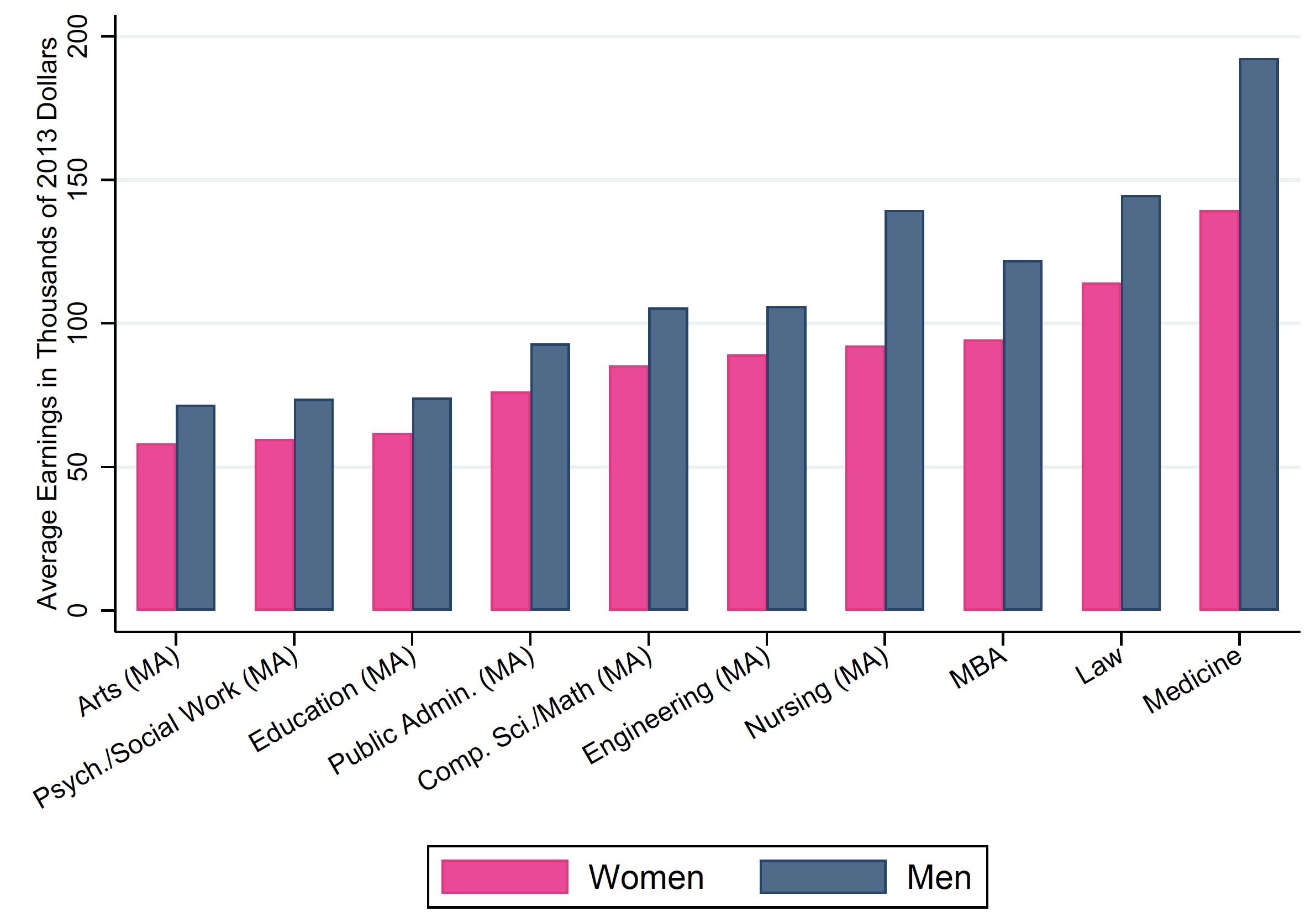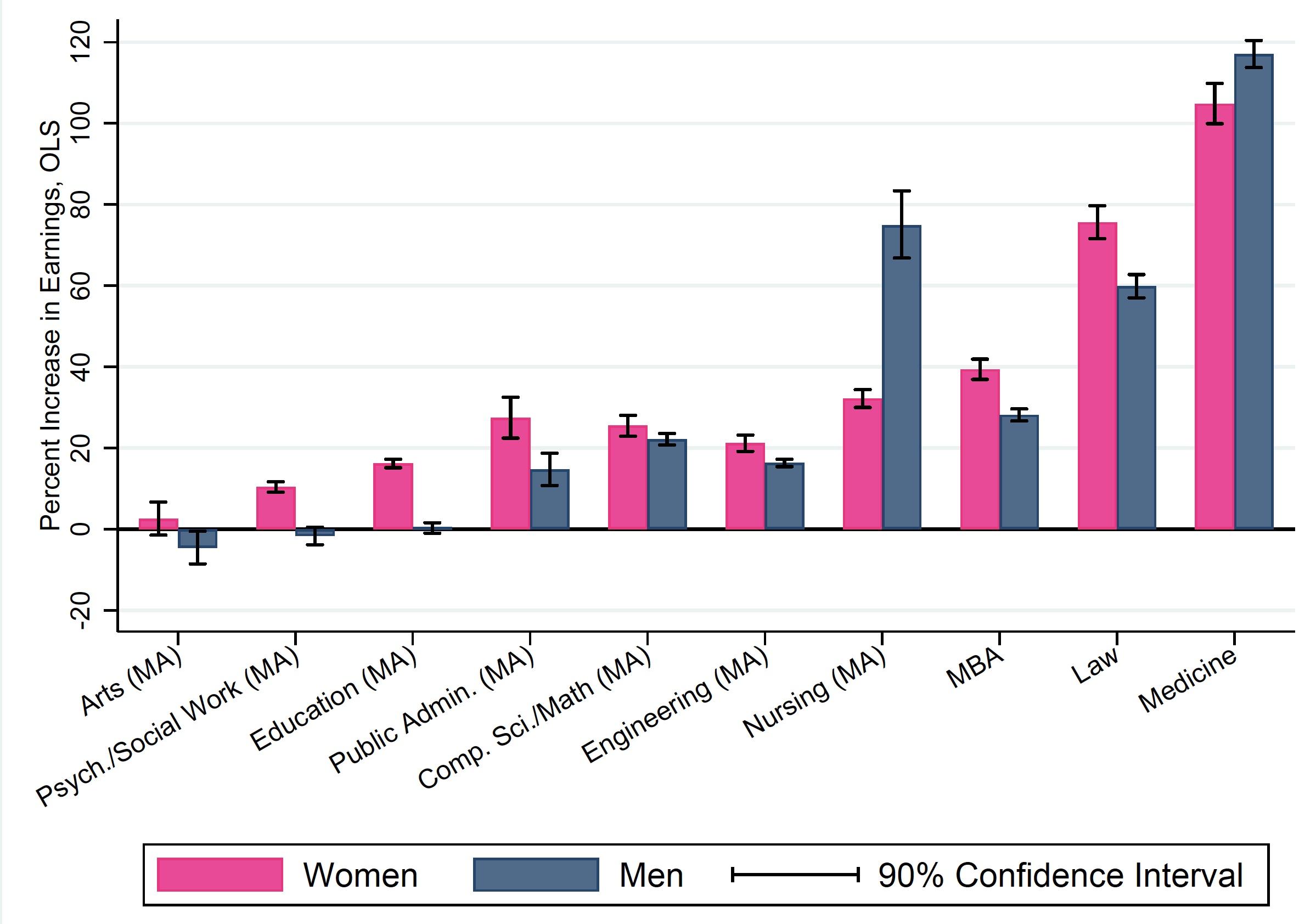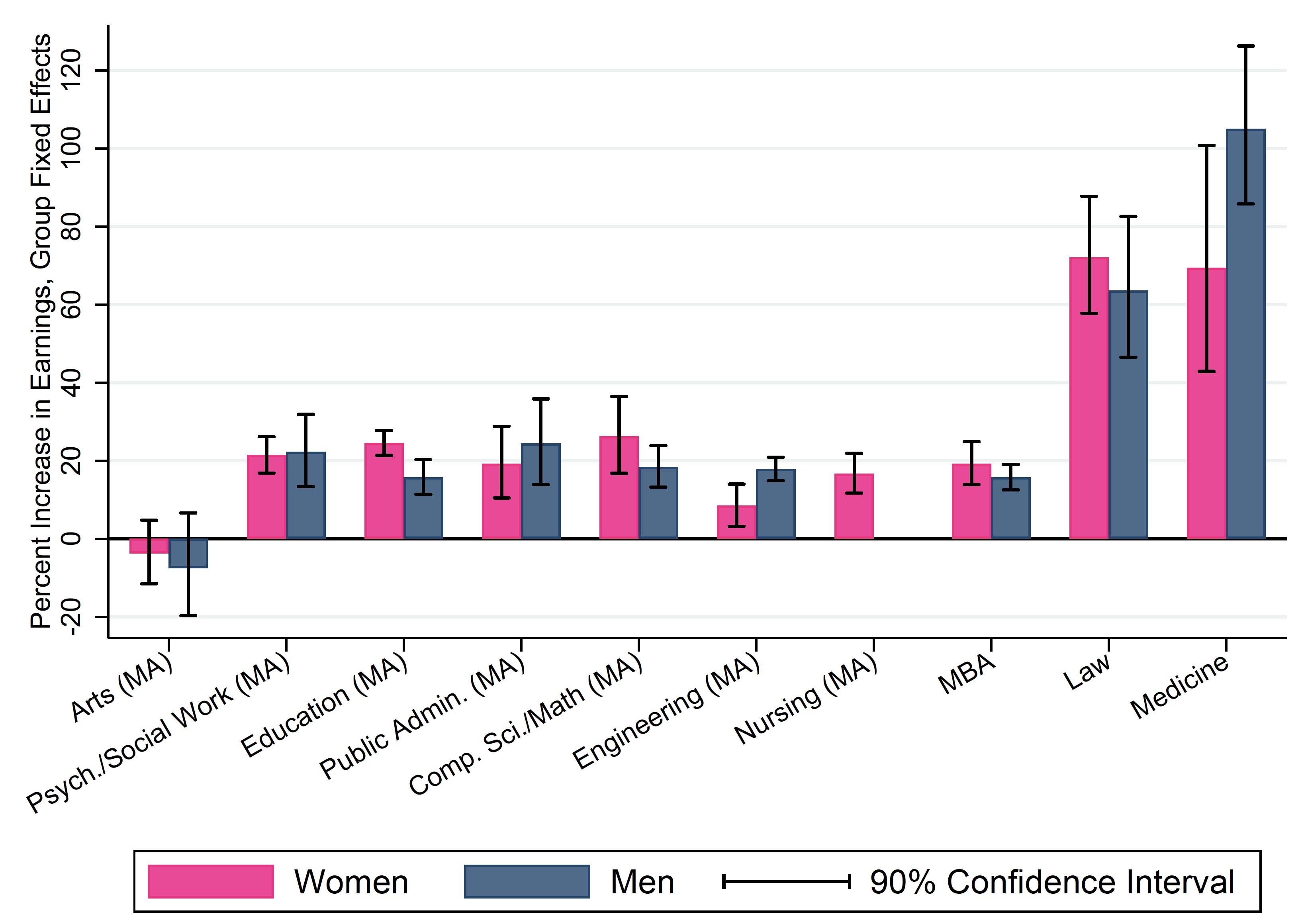Men earn more money than women. This gender gap exists not just in the general population, but also between highly educated men and women. In fact, Blau and Kahn (2017) find that it is among the highest earners that gender gaps remain the largest. One possible reason is that women choose specific graduate degrees that pay less. Another is that women might benefit less from graduate education.
Our new paper (Altonji et al. 2022) studies college graduates surveyed by the National Science Foundation between 1993 and 2019. We document the average earnings for full time workers with 19 different master’s and professional degree categories ranging from a master’s in education to an MBA to medical school. In all 19 categories, men earn more than women on average. (The appendix to Altonji et al. (2022) reports more disaggregated data on earnings by gender for 168 advanced fields and 144 college majors. Men earn more in all but 9 graduate fields). Figure 1 plots the average earnings for ten specific fields of study. The figure shows large differences across graduate degrees for both men and women. For example, men with medical degrees earn an average of about $192,000 (in 2013 dollars) while men with a master’s in art (fine arts and the performing arts) earn only $72,000. The corresponding earnings for women are $139,000 and $58,000, respectively.
The differences highlighted above raise questions about how the returns to graduate school contribute to the earnings gap. While men earn more than women in all fields, the causal returns can be higher for women if their relative increase in earnings is higher than for men. That is, even though women have both lower pre-degree salaries and lower post-degree salaries, some degrees increase earnings more for women than men.
Figure 1 Average earnings by degree and gender
Note: Degrees marked ‘MA’ indicate any master’s degree, including both MA and MS degrees. Estimates are for full time workers. They are based on multiple waves of the National Survey of College Graduates between 1993 and 2019 and multiple waves of the National Survey of Recent College Graduates between 1993 and 2010. See Altonji et al. (2022), Table 1.
Regression-based estimates of returns to degrees
Rather than just simple averages of the differences in earnings, we are interested in the causal returns to obtaining a degree. We recognise that the people who get graduate medical degrees are different from the people who get graduate arts degrees. For example, they likely differ in what they studied in college, their grades, and their work preferences. The average earnings presented above are thus insufficient for estimating the causal returns to a degree.
As a starting comparison, we run an ordinary least squares (OLS) regression of log earnings on graduate degree type, controllingfor college major, parental education, demographics, age, and year. We converted the coefficients for the selected degrees to represent the percentage increase in earnings (Figure 2). An OLS regression simply compares the returns to individuals who choose to get graduate degrees to individuals who are similar in observable ways, including college major, but do not choose to go to graduate school. This helps give us an idea of the average differences in returns to each degree by gender. We observe that some degrees have higher returns for men (e.g. nursing) and some degrees have higher returns for women (e.g. education). However, it is unlikely that a simple OLS regression captures the true causal returns to a degree because individuals who do and do not choose to go to graduate school are likely different in other important ways.
Figure 2 Percentage effect of graduate degrees on earnings by gender, OLS
Note: The percentage increase in earnings for an MBA is calculated as exp(ln(γMBA_OLS)-1)*100, where exp(γMBA_OLS) refers to the OLS regression coefficient relating an MBA to ln earnings. The percentage increases for the other degrees are calculated in similar fashion. The black lines show the 90% confidence intervals. See Altonji et al. (2022), Table 2 columns 2 and 6.
Moving towards causality
To better estimate the causal returns to graduate degrees, our new work (Altonji et al. 2022) adopts the method first proposed by Altonji and Zhong (2021). Many people work before attending graduate school, so we can compare earnings before and after attendance to estimate the effect of the degree. This is more convincing than the comparison offered by OLS between individuals who choose to earn degrees and those who do not. The estimation strategy allows us to look not only at individuals for whom we have both types of earnings data – before and after graduate school – but also to include individuals with only one type – before or after graduate school. To do this, we group people based on their combination of undergraduate majors and graduate degrees. Roughly speaking, we compute the difference between average pre-graduate school and average post-graduate school earnings of all people who major in business and go on to get an MBA. The estimate of the value of an MBA is an average of the pre- and post-graduate school difference for the various undergraduate majors. To account for age and other factors we implement the approach by simply adding separate intercepts (fixed effects) for each degree combination to the OLS regression model discussed above. We call the procedure ‘FEcg’, where ‘c’ and ‘g’ denote the college major and the graduate field. Controlling for these degree combination fixed effects helps isolate the effect of the graduate degree on its own.
The degree combination fixed effects strategy likely better approximates the true causal effects of obtaining a graduate degree than OLS. Comparing the Fecg estimates (Figure 3) to those produced by OLS (Figure 2), we see a strong positive correlation, but the Fecg estimates tend to be above OLS for lower paying fields such as psychology and education and below for higher paying fields such as an MBA. Part of the difference is due to sampling error. This is reflected in the wider 90% confidence intervals (the black lines) shown in the figures. Across the 19 degrees, the Fecg estimates are usually above OLS for low paying fields such as psychology/social work. Furthermore, the Fecg estimates of the female-male gap in returns are smaller than OLS in 14 of 19 cases. For example, the female-male gap in returns to the master’s in education shrinks from 15.3% to 8.8%. The returns to psychology/social work for men are close to the returns to women instead of slightly negative as in the OLS case, although the Fecg estimates are less precise. Turning to the higher paying fields, while OLS suggests that women received higher relative returns to an MBA and to law, the Fecg method suggests the opposite. These differences highlight the importance of addressing causality, as the naïve estimates from OLS can produce misleading conclusions.
Finally, note that while some fields, such as education, may be relatively more financially beneficial to women in percentage terms, our analyses all take place within a context in which (1) women are overrepresented in fields (such as education) that lead to lower paying jobs and (2) women earn less than men who have the same graduate degree (see Figure 1).
Figure 3 Percentage effect of graduate degrees on earnings by gender, degree group fixed effects (Fecg)
Note: The percentage increase in earnings for an MBA is calculated as exp(ln(γMBA_FEcg)-1)*100, where γMBA_FEcg is the Fecg estimate of the coefficient relating an MBA to log earnings when college major/graduate field combination fixed effects are included. See Altonji et al. (2022) Table 2 columns 1 and 5. The percentage increases for the other degrees are calculated in similar fashion. We do not report the nursing estimate for men because it is very imprecise. The black lines show the 90% confidence interval estimates.
More hours or a higher wage?
A degree that increases the earnings of its graduates could do so through two pathways: it could (1) raise the hourly wage of its graduates or (2) raise the number of hours its graduates work, even if they earn about the same rate per hour as non-graduates. We find that most of the returns to graduate school come from a higher hourly rate, but there are some jobs in high-paying fields such as law, medicine, and business for which the increase in hours plays a notable role in the returns. Up to a quarter of the returns to these degrees can be attributed to the longer hours. This is consistent with Goldin and Katz’s (2011) and Goldin’s (2014) finding that the most lucrative jobs often involve long hours and/or are less family-friendly in other ways.
Limitations
Although the degree combination Fecg improves upon OLS, its estimates can be interpreted as fully causal only under strong assumptions. The main challenge is that the group fixed effects method assumes that earnings before graduate school are the same as what they would have been if the person chose never to attend graduate school, after accounting for age. This assumption may fail for a number of reasons discussed in Altonji et al. (2022). For example, suppose a student takes a low-paying job as a lab assistant in order to prepare for medical school. The lab assistant job probably does not reflect what the individual’s earnings would have been had they not decided to obtain a medical degree. Given these limitations, the Fecg values are likely an improvement over OLS but not rock-solid causal estimates of returns.
Another limitation is that the Fecg estimates only refer to students who work between college and graduate school. The returns for the minority of students who directly enter graduate school from college might differ. Additionally, these estimates reflect only the average returns for people who obtain graduate degrees, not the returns for marginal students, which may be more relevant to policy makers who are deciding whether to expand a graduate programme.
Conclusion
Students pursue master’s and professional degrees with the expectation that graduating will increase their future earnings. It is important for researchers, policymakers, and students themselves to understand the magnitude and determinants of those returns to make informed decisions about which degrees are the best investments and for whom. Our estimation strategy provides this information more convincingly than previously available techniques. While men earn more than women in all fields we studied, we find that some fields (e.g. education, business, and law) offer relatively higher returns to women and other fields (e.g. medicine, nursing, and public administration) offer relatively higher returns to men. These returns to graduate school seem to be mostly due to an increase in the hourly wage rather than to an increase in hours worked.
Authors' note: We thank Anna Esenther for helping us draft this column.
References
Altonji, J G, J E Humphries and L Zhong (2022), “The Effects of Advanced Degrees on the Wage Rates, Hours, Earnings and Job Satisfaction of Women and Men”, NBER Working Paper No. w30105.
Altonji, J G and L Zhong (2021), “The labor market returns to advanced degrees”, Journal of Labor Economics 39(2): 303-360.
Blau, F D and L M Kahn (2017), “The gender wage gap: Extent, trends, and explanations”, Journal of Economic Literature 55(3): 789-865.
Goldin, C (2014), “A grand gender convergence: Its last chapter”, American Economic Review 10(4): 1091-1119.
Goldin, C and L F Katz (2011), “The cost of workplace flexibility for high-powered professionals”, The Annals of the American Academy of Political and Social Science 638(1): 45-67








